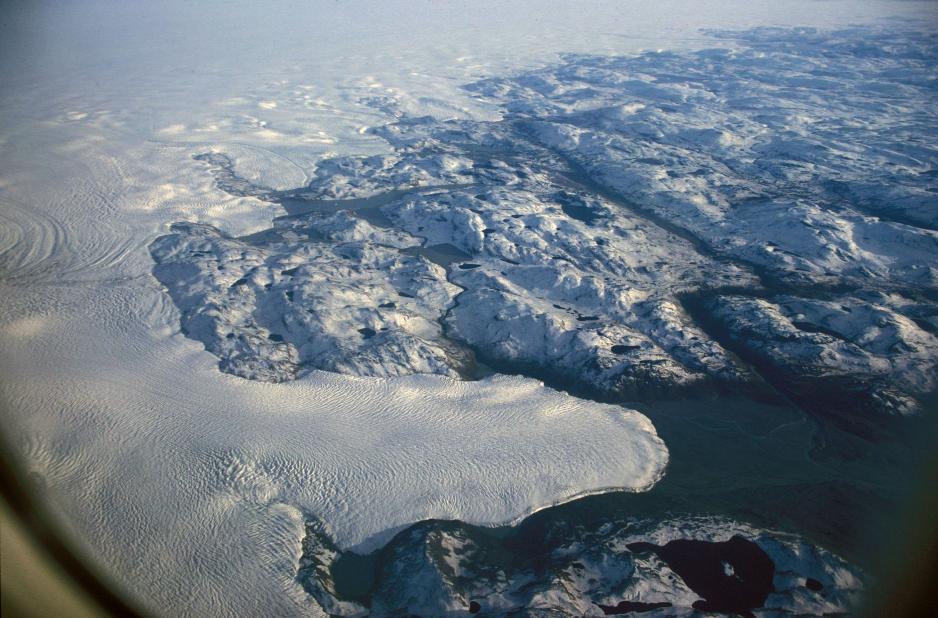Is Technical Climate Engineering Heading for the Arctic? Experts Open to Climate Engineering to Prevent Climate Disasters

Scientists and politicians are warming up to the idea that it takes more than reducing CO2 emissions to avoid climate disasters. The hypothesis is that we have to intervene in nature; re-create polar ice, block the sun, change ocean streams or suck CO2 out from the atmosphere to prevent climate disasters. (Illustration from Greenland ice melting: Hannes Grobe, Alfred Wegener Institute for Polar and Marine Research)
Climate. Shall we block the sun’s rays or perhaps re-create polar ice with technological interventions to halt climate changes? Or will this kind of technological fix just make things worse?
In 2016, American scientists suggested placing millions of windmills in the Atlantic Ocean to limit global warming. The mills were to lift the ocean water up on the remaining ice cap, where it would freeze into new ice and help re-create the polar ice’s ability to deflect sunrays. The proposal was published in a serious scientific journal and although the windmills were never built, this kind of technological ideas are more popular than ever.
A series of related proposals are today the subject of new and deep controversies in international climate negotiations. Scientists and politicians are beginning to realize that it takes more than just cutting CO2 emissions to avoid a climate disaster.
Many are convinced that we will have to intervene in nature itself – to re-create the polar ice, block the sun’s rays, change ocean streams or suck CO2 out from the atmosphere – in order to prevent climate catastrophe.
The phenomenon is called “climate engineering” and has suddenly gained prominence:
- It is important that we watch our step now. Technology has crept in on us, amongst others in light of the 2015 Paris Accord, which states that the global temperature may increase with a maximum of 1.5 to 2 degrees. The IPCCC climate scenarios have included technological assistance to reach the Paris goals, which means that in theory, we are already dependent on technology – technology that does not exist yet, says Olaf Corry, Lecturer at the Institute of Political Science at Copenhagen University and researcher in climate politics, climate engineering and security. He is currently guest researcher at the Centre for the Study of Existential Risk at Cambridge University.
Crocodiles
The debate keeps gaining momentum. When the Idai cyclone ravaged southeastern Africa mid-March this year, some places received 60 centimeters of rain within the span of just a few hours and the floods in the area are still massive. The International Committee of the Red Cross reports that up to 2.6 million people in Madagascar, Mozambique, Zimbabwe and Malawi were affected.
At least 800 people died, thousands are msising, wounded, forced to run away or homeless. They live in the risk of crocodile attacks, famine and epidemics. Bridges, dams and villages have disappeared. Decades of reconstruction remain.
The World Meteorological Organization’s Secretary General, Petteri Taalas, included the disaster in the WMO climate update at the end of March.
- Even if it is still early in the year of 2019, we have already seen extreme weather examples, the last example being the Idai tropical cyclone […] It may prove the most devastating weather disaster in the southern hemisphere ever, he said.
The UN Environmental Programme (UNEP) reported at the same time that the Arctic will warm up by three to five degrees by 2050, regardless of what we do. The claim is disputed, though there are others along the same lines: Met Office Norway reported that Svalbard has had above-average temperatures for the past 100 months.
Block the sunrays
The most contested technique is that which aims at methods for blocking the sunrays, so-called solar radiation management.
Several sunray deflecting techniques are currently under development, in particular in the USA, where scientists of a.o. Harvard University are researching how artificial particle clouds consisting of water, limestone, sulphate or sulphur acid can block the sunrays.
Others are talking about helping the ocean through pumping rich, more CO2-absorbing water masses from the depth up to the surface, a technique with which a.o. Chinese scientists have experimented.
The Climaeworks tech company in Switzerland is developing plants that suck CO2 out from the atmosphere and transform it into a material matter. Cilmeworks is already running a smaller plant on Iceland, sucking CO2 out from the atmosphere and attaching it to lava layers.
In Alaska, researchers are experimenting with reinforcing the remaining polar ice and re-creating that ice which is already lost, using tractors to distribute large amounts of silicon capsules across the ice to reinforce its ability to deflect sunrays.
The project is called ICE-911 and the team behind it wants to expand into other parts of the Arctic.
There are others who envision planting large CO2-absorbing forests, preferably supplied with production of biofuel to replace diesel and petrol. There is talk about new green areas the size of India.
None of these solutions have been tested at any larger scale, however, the demand for technological disaster assistance is now so great that political fights have broken out between those who see the advantages of using technology to counter climate changes and the opponents, who fear irreversible damage being done to nature as well as political undermining of the Green Shift.
The opponents argue that climate engineering will provide Saudi Arabia, Donald Trump, Vladimir Putting and other stakeholders in the continued consumption of coal, oil and gas with an excuse to continue “business as usual”.
USA blocking in the UN
During a UNEP summit in Nairobi where leaders from 161 nations met, the conflict reaches its climax so far. A series of governments, led by Switzerland and Mexico, try to achieve consensus on taking the first steps towards international political control over the new climate technologies.
- There is a risk that climate engineering is implemented without any form of international control, and we are most concerned about it. Solar radiation management tests have already been conducted and research is underway. We can no longer close our eyes and tell ourselves that this is just science fiction, said Franz Perrez of the Swiss Environmental Department to the Climate Home News web site.
The increased control proponents had conducted solid preparations and the proposal received the support of the EU. However, the attempt failed when diplomats from the USA, Saudi Arabia and Brazil orchestrated a counter-offensive that blocked a decision. The American diplomats argued that the UN’s IPCC should mange this matter as the Panel is a non-partisan and independent scientific body, while the UNEP also has to take fauna, flora, social and social and economic sustainability into account in a wider perspective.
The big bad fix
The divide has entered the environmental movement too. In the latest edition of The Circle journal, published by the Arctic division of the World Wide Fund for Nature, the front page reads “What happens after 1.5 degrees?” Several articles embrace more climate engineering research.
That is quite astonishing, as other environmental movements and climate policy think-tanks until now have considered climate engineering primarily as a series of speculative proposals that carry the potential of causing irreversible damage to nature, the ozone layer, the ocean and the whole earth.
In an 80 page long report called “The Big Bad Fix – The Case Against Geoengineering” from 2017, German Heinrich Böll Foundation and two other green institutions, the ETC Group and Biofuelwatch, list an extensive series of arguments against geoengineering.
In the report, the Paris Accord was accused of breaking the ground for a group of powerful, oil-fixated climate deniers.
“Instead of committing to reducing emissions, they defend their own economic status quo. When the accounts are to be settled in 2020 or soon thereafter, climate information will be even more alarming and tell us that the ‘only’ solution drastic enough will be a ‘techno-fix of geo engineering’,” the report reads.
The report further describes how some of the climate engineering research is funded by oil companies as well as private donors, including Bill Gates of Microsoft.
The critique continued in February, in the book “Fuel to the Fire: How Geoengineering Threatens to Entrench Fossil Fuels and Accelerate Climate Change” was published by the Center for Environmental Law in Washington. “Almost all proposals about geoengineering will serve continued use of fossil fuel instead of solving the climate crisis” is one of its arguments.
Can we afford not to?
However, the criticism has not stopped the wave. British polar ice expert Peter Wadhams in The Circle recommends that the world society makes an effort to such CO2 out from the atmosphere. Wadhams assumes that 20 billion tons of CO2 are sucked out annually – for all future. “We have to find out immediately which technique that holds the greatest chance of becoming a success,” he writes.
Frank Keutsch, professor of chemical biology and researcher on solar radiation management, in The Circle recognizes the fear of unintended damage to nature and does not reject the argument that climate-denying governments probably will use “technology that soon will save the globe” as an argument to continue their production of oil and gas.
- The idea of pouring million of tons of sulphur acids into the stratosphere sounds insane and scary to many. However, if you look at climate change and our current course, it is equally terrifying. We have to do something, and the reason we are conducting research is that we have to have a head start, he says.
He fears that climate changes will catch up with research and that solar shielding or other technologies will be applied on a larger scale prior to their being sufficiently tested.
Weather as weapon
Olaf Corry of Copenhagen University has a particular interest in how climate engineering interacts with security politics.
- Climate engineering will hardly be interesting as an attack tool, however, the strategic importance of being able to manipulate the climate should not be underestimated, he says.
Solar blocking on a global scale would presumably require 4-500 specially designed planes to be in the air at all times, and Corry assumes that only military organizations hold such capacities.
Solar blocking should also be protected against sudden temperature increases, as well as against terrorists and hackers.
- Climate engineering will be interesting for a major power, even though another major power may be leading the development. There is great interest in who is developing what and how to manage it, he says.
Using weather as a weapon is well known in modern history, in particular from the Vietnam war, when the USA tried conquering the Vietcong guerrilla by sprinkling silver iodide onto the clouds to increase monsoon rains. In 1978, it led to a global ban against using the weather as a weapon – though it also remains the world’s first attempt at climate engineering.

